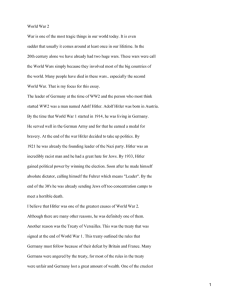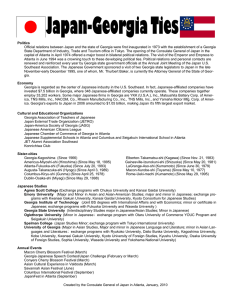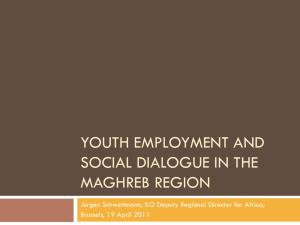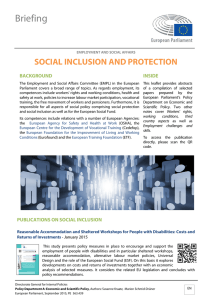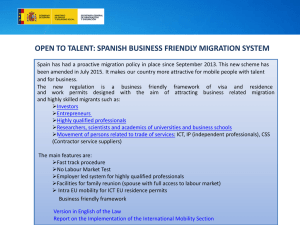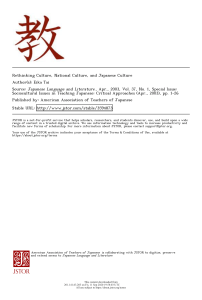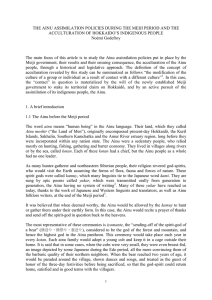The “good wife and wise mother” pattern
Anuncio
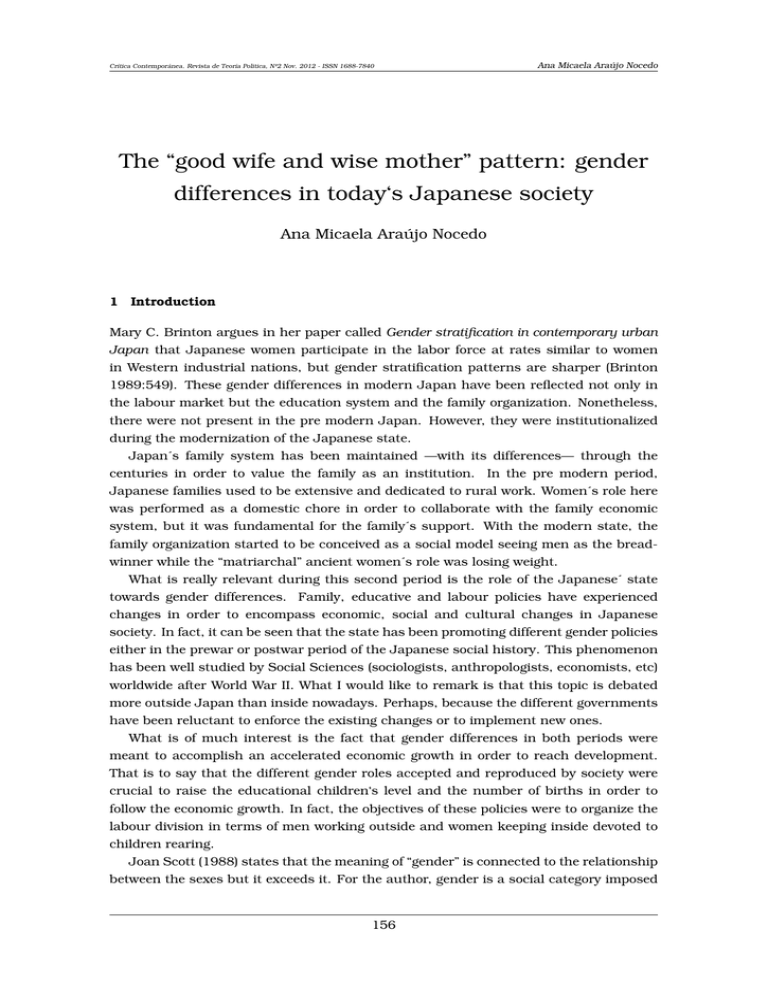
Crítica Contemporánea. Revista de Teoría Politica, Nº2 Nov. 2012 - ISSN 1688-7840 Ana Micaela Araújo Nocedo The “good wife and wise mother” pattern: gender differences in today‘s Japanese society Ana Micaela Araújo Nocedo 1 Introduction Mary C. Brinton argues in her paper called Gender stratification in contemporary urban Japan that Japanese women participate in the labor force at rates similar to women in Western industrial nations, but gender stratification patterns are sharper (Brinton 1989:549). These gender differences in modern Japan have been reflected not only in the labour market but the education system and the family organization. Nonetheless, there were not present in the pre modern Japan. However, they were institutionalized during the modernization of the Japanese state. Japan´s family system has been maintained —with its differences— through the centuries in order to value the family as an institution. In the pre modern period, Japanese families used to be extensive and dedicated to rural work. Women´s role here was performed as a domestic chore in order to collaborate with the family economic system, but it was fundamental for the family´s support. With the modern state, the family organization started to be conceived as a social model seeing men as the breadwinner while the “matriarchal” ancient women´s role was losing weight. What is really relevant during this second period is the role of the Japanese´ state towards gender differences. Family, educative and labour policies have experienced changes in order to encompass economic, social and cultural changes in Japanese society. In fact, it can be seen that the state has been promoting different gender policies either in the prewar or postwar period of the Japanese social history. This phenomenon has been well studied by Social Sciences (sociologists, anthropologists, economists, etc) worldwide after World War II. What I would like to remark is that this topic is debated more outside Japan than inside nowadays. Perhaps, because the different governments have been reluctant to enforce the existing changes or to implement new ones. What is of much interest is the fact that gender differences in both periods were meant to accomplish an accelerated economic growth in order to reach development. That is to say that the different gender roles accepted and reproduced by society were crucial to raise the educational children‘s level and the number of births in order to follow the economic growth. In fact, the objectives of these policies were to organize the labour division in terms of men working outside and women keeping inside devoted to children rearing. Joan Scott (1988) states that the meaning of “gender” is connected to the relationship between the sexes but it exceeds it. For the author, gender is a social category imposed 156 Crítica Contemporánea. Revista de Teoría Politica, Nº2 Nov. 2012 - ISSN 1688-7840 Ana Micaela Araújo Nocedo to sexed bodies but not only related to “sex roles”. This means that “gender” involves all types or relationships between men and women but not only based on sexuality. The author also expresses that the gender role in history is undermined for women. There are differences between men and women in many aspects such as in the social roles apart from the biological differences. The History has had a specific view on this field due to the paradigm that has involved this insight on women. What is more, the author states that gender is related to power because it puts on debate the way which social differences are constructed and how inequities has been reproduced by societies. An historical perspective on gender could change the historical approach according how the different collectives have seen this issue. Leading on from this, Sylvia Chant says that gender inequalities occur in “public” arenas such as the labour market and formal politics, as well as the nominally “private” sphere of home and household. Gender inequalities in these different domains are not only interrelated with one another, but have major synergies with development (Chant 2009:205). These dimensions will be taken into account —except for the formal politics— throughout this paper in order to frame the main topic. During pre World War I, women´s role evolved to the mother´s role by means of women´s education. Theories about the nature of motherhood started to preconize its role as a natural spirit to follow. This attitude towards women gave them a new role in the family system and the society as a whole. The theoretical concept of motherhood emerged to link women and their responsibilities as mothers in a different way to the one of the nineteenth century. The term “motherhood” (BOSEI) is the translation of a Swedish word used by Ellen Key, MODER SKAP (motherhood, maternity) , which came into use in the latter half of the 1910s and was well established by the latter half of the 1920s (Koyama 1994: 49). The first change produced upon this social thinking was produced by World War I (1914-1918) when women started to have a fundamental role in the economy system as a productive unit in the place of men. Furthermore, during the militarization prior World War II the Japanese state saw the gender roles as essential for the nation building and economic development. The social changes determined both by the World War II and the second demographic transition altered the traditional Japanese family system —i.e— into a modern nuclear family. With it, the motherhood role of the woman turned into a full-time housewife role among the family organization. In short, as Uno claims, from the late 1890s until the end of World War II, “good wife, wise mother” increasingly pervaded the mass media and the higher levels of public and private girl´s schools, institutions that influenced the upper ranks of society, and came to constitute the official discourse on women in Japan (Uno 1993a: 294). Nevertheless, this social pattern promoted by the state was not homogeneous and did not fulfill the role´s expectations of every woman regardless their social class. Despite there were social changes for Japanese women since World War II conquested by women’s liberation movement in the 70s, the division of labour was confined to pursue the class media model of “good wife and wise mother”. Indeed, the claims of this social movement did not make any changes on women´ s gender role. This social wisdom was reflected on other realms like the labour market and the social benefits. 157 Ana Micaela Araújo Nocedo Crítica Contemporánea. Revista de Teoría Politica, Nº2 Nov. 2012 - ISSN 1688-7840 Furthermore, this phenomenon was reassured by inequities in the mentioned areas as a consequence of a social model promoted by the state. In the context of economic slowdown and major demographic shifts in the 1990s the Japanese society has undergone a number of significance changes. The marriage rate has fallen, while the divorce rate has risen. The patterns of cohabitation of members of extended family have also shifted with the decrease in “traditional” three generations households and with the increase in the number of young men and women who continue to stay single and live with the parents (Rebick et al 2006: 3). In terms of these contemporary changes, the family system has suffered structural changes and the “family” has adopted different words to be called such asHAZOKU , KATEI , SETAI and the ie. (Rebick et al 2006: 11). Women´s role towards family and work have also changed. On one hand, there has been a shift in the gender balance in the workplace and the homemaking started to be shared by the two sexes. On the other hand, the three generations (grandparents, parents and sons) living under the same roof is not longer an attractive model for the Japanese society. This new social arrangement has stretched the gap between roles. The full-time or “professional” housewife (SENGYO SUFU) was the center of several discussions in postwar Japanese society. First introduced by Ezra Vogel‘s study on J APAN´S N EW M IDDLE C LASS (1963) as the counterpart of the salariman, the housewife has become a symbol of postwar middle-class family life. Dedicated to the well-being of her family and devoted to the educational success of her children, the role of the housewife has been considered as a profession, lifelong career, and a sign of status matching with her white-collar husband (Hendry 1993; Imamura 1987; Vogel 1978 in Ezawa 2009: 19 in Ishida and Slater 2009). This organization system is pretty admitted in today´s Japanese society. In short, the middle-class women´s model has not been much altered. However, it may seem different since postwar. Furthermore, a new insight over Japanese class structure has been developed in the last decades since researches on systematic studies have increased on class aspects derived from gender differences. Women´s dispositions to motherhood and the role of full-time housewife started to be seen as a “class attribute” more than an homogeneous social model to be pursued by them. Above all, between upper and lower classes as a consequence of an industrialized economy. This aspect of social class will appear in the middle-class women in contrast to blue-collar women forming part of lower classes. This outstanding phenomenon has not only been studied in Japan but in other countries by multidisciplinary research groups (Osawa 1993; Collins 1994; Ochiai 1994; Ginsburg and Rapp 1995; Gordon 1997; Osawa 2002; Ezawa 2009) and sheds light on gender aspects of social class in contemporary Japanese society. For this reason, the main goal to achieve in this research is to describe how policies in pre and postwar Japanese society have shaped women‘s role in different ways compared to men. Such policies will be approached from three dimensions through both periods: the family system, the education and the labour market. The main topic that will be introduced is that these realms have been seen in the long term as relevant spaces for the reproduction of gender differences in terms of promoting a social model based on the labour division. Firstly, it will be discussed how the state’s policy in prewar Japan saw women´s 158 Crítica Contemporánea. Revista de Teoría Politica, Nº2 Nov. 2012 - ISSN 1688-7840 Ana Micaela Araújo Nocedo role as essential for nation building and economic development. Here the concept of ryosai-kenbo or “good wife and wise mother” will be introduced showing the evolution of the model by means of state policies. In this way, the concept of motherhood will be approached upon gender differences and the relation between women and the state. A couple of examples will be presented in order to depict the role of women into the family system, education and labour market in that period. That is to say, that the essay will take into account these mentioned institutional dimensions that affect the social and economic world of women in a different way. Secondly, the postwar social changes will be traced upon womanhood and the shifting paradigm about the “women’s issue”. It will be discussed how women’s role has been institutionalized in different ways than men ones considering the mentioned institutional dimensions again during the economy industrialization. As it will be seen, the idea of RYOSAI - KENBO will be shaped under the concept of full-time housewife instead of motherhood. Finally, some conclusions will be drawn in order to get a big picture of the division of labour based on a gender bias in contemporary Japanese state. It will be seen that the term is no longer used in postwar Japan but its meaning has remained not only in the social wisdom but as a model in the middle-class family and gender policies of the government. 2 Modern Japan and the reorganization of the “good wife and wise mother” pattern It can be distinguished two moments in the history of Japan in terms of policies towards women. The first moment belongs to the post World War I and the second one to post World War II. In the first case, the term of RYOSAI KENBO or “good wife and wise mother” was adopted by the state in a different way as it used to be. First of all, in1899 the concept became to be the cornerstone of the curricula of girls´ higher schools attended by daughters of the elite, but it was not explicitly introduced into the curricula of elementary schools until the 1911 revision of the ethics textbooks (Uno 1999:44). The term started to embrace a specific perspective upon women in Japan after the Sino Japanese War of 1894-95 (Uno 1993a)1 . As a consequence of the war, women encountered themselves with a prominent role in Japanese society. First of all, due to the Ministry of Education that defined women as managers of domestic affairs in households and nurtures of children (Uno, 1993a). The Empire needed women dedicated to household chores and child-rearing in order to have healthy and educated children. This was carried out to prevent the Western invasion. So, this nationalism configured women to a key role related to the housewife and motherhood role in society. Women´s image related and dependent of the family system did not exist in the Edo period. After the Meiji Restoration (1868) the emergence of a modern nation saw the role of women beyond the domestic duties. That is why women started to be engaged in other inside activities different from the traditional housekeeping. Consequently, the rearing, 1 As Kathleen Uno argues, a definition of Japanese woman as “good wife, wise mother” ( RYOSAI KENBO ) emerge in Japan at the end of the nineteenth century. In the aftermath of the Sino Japanese War of 1894-95, prominent men, especially officials in the Ministry of Education (M ONBUSHO), began to champion “good wife, wise mother” as woman´s proper role in imperial Japan (Uno 1993a: 294-295). 159 Crítica Contemporánea. Revista de Teoría Politica, Nº2 Nov. 2012 - ISSN 1688-7840 Ana Micaela Araújo Nocedo educating and spousal role was seen as a builder of nationality and citizenry (Koyama, 1994). Consequently, the state saw on women´s education the way to accomplish this social model in the private sphere of the family. As Ochiai (1996) poses, this role of housewife existed even in premodern times. Despite the traditional family system i.e was patriarchal, women helped with the agriculture, domestic duties or the small enterprise of the family such as women of the Western world used to do during the past times2 . However, the concept of housewife was being adopted amongst the middle class during the Taisho Period (1912-1926). It seems that the family evolution configuration used to follow the same pattern as the Western families but much later. That is how the term housewife (OKUSAN) is described. However, the term was before adjudicated to the married women of the warrior class. Now, the term is used to design the wife of a salaried employee [. . . ] when the economic boom and rapid industrialization which followed the First World War generated a whole new class of what we would now call white-collar workers, those who did the administrative work of large organizations (Ochiai, 1996:31-32) That “new middle class” was opposed to the merchants —a defined social class in Japan at that moment— and also circled the government employees and teachers. So, the term “housewife” appeared to be a modern concept but replace an antique not paid work. In addition, this middle class who moved to residential suburbs went to work downtown. Consequently, new practices were adopted: workplace and home were separated. So, the private and public realms gained a specific space. In this new scenario, housewife was supposed to remain inside home helping with the domestic affairs in the absence of the husband (Ochiai, 1996). As a result of the development and industrialization of the Japanese economy, husbands started to earn enough to keep their wives without working. That is why housewives were supposed to remain inside doing by themselves the work that seemed to be related to their sex, such as domestic chores and other things. In this way, women could contribute to the economy through helping their husbands by means of the housekeeping and the children rearing. That was the place seen by the state for a social and economic standpoint. Achieving this mother’s education was important, therefore the state promoted women’s education so as to enhance children education as well. The first turning point related to women´s education appeared after the First World War with the emergence of the women´s issue (FUJIN MONDAI). As part of it, the state saw women as playing a key role in the education and health of their children. In order to satisfy national purposes the state invested in women´s education and they started to share the same space as men at school. Men were identified as members of the nation by their productive capacity and military service, while women were recognized as citizens for their domestic support for those male activities and for the next generation to be reproduced. Thus, the ideology of “good wife and wise mother” also underpinned the development of a sexual 2 Ochiai (1996:58-59) states that the basic unit of traditional social organization in Japan, the i.e is a corporate body which owns household property, carries on a family business, and emphasizes the continuity of the family line and family business over generations. This institution became established among the aristocratic and warrior classes a thousand year ago, and among the peasant class around the eighteenth century 160 Crítica Contemporánea. Revista de Teoría Politica, Nº2 Nov. 2012 - ISSN 1688-7840 Ana Micaela Araújo Nocedo division of labor, which appeared as late as the end of the nineteenth century and was indispensable for the creation of a modern society (Koyama, 1994:31-32). Then, the role of the state was paramount in order to impulse a clear division of gender tasks. However, it is difficult to see the modern Japanese state as the creator of a new model for women´ social role. Women´s role was attached to a social structure that was inherited since the samurai warriors where men were thought to be loyal, responsible and dedicated. Qualifications that were not suitable for women. So, the new modern concept of women after the First World War maintained the same role for women as in the ie family system but adapted to new economic and social demands. Since 1910s the concept of “good wife and wise mother” started to be criticized by men and women intellectuals and the women’s issue (FUJIN MONDAI) appeared to be a full-fledged social problem (Shizuko, 1994). Most of the theories on women’s education that were published in both posterior decades attempted to discuss the role of women in society without sharing a common point of view. Furthermore, most of the published articles during this period started to take into account gender issues from the West. As an example, theories on women´s liberation that were well known in the West a century ago were being introduced much latter in Japan. As the Western countries were showing women’s conquests of social rights through the suffrage, the Japanese state was just starting to confront with the coming new women’s movements. That is why the state put an eye on women circumstance in Japan and tried to regularize their education and prohibit social and political rights for the sake of the nation (Uno, 1993a). In this way, the state institutionalized women´s role and controlled the new social movements. In accordance to Ochiai (1996), this stage does not correspond with the first wave of women´s movement in terms of contents. After the First World War, Japanese women´s movement entered to a hiatus as it happened with the Western countries until the end of the Second World War and specifically in the seventies when it acquired more impulse due to the civil and political rights that were gained by women. This will be explained in detail forward. Nevertheless, the beginning of the twentieth century as a period when the women´s suffrage movement in the West was at fever pitch, and news of its activities was [sic] soon carried to Japan. Through the newspapers, Japanese readers learned more or less contemporaneously what issues Western women were fighting for (Koyama 1994:33). Koyama (1994) identifies two factors that allowed the emergence of women in the public arena. Firstly, the rapid diffusion of secondary education among women. According to the M ONBUSHO NENPO (Annual report of the Education Ministry), for example, the number of women studying at women’s schools for secondary education increased 230 percent between 1910 and 1920 (Koyama, 1994:34).This allowed them to get clerical jobs and professionals ones. Women started to work outside in varied jobs as shop workers, typists, telephone operators, educators, nurses and so forth (Koyama, 1994). It could sound a bit contradictory because women´s participation in the labor market was each year higher until the second half of the 50s. Secondly, educational policy was focused on the Japanese upper classes. Indeed, women of the middle and upper classes used to continue their studies beyond secondary school. In the mid-1920s, about 10 percent of women completing compulsory education 161 Crítica Contemporánea. Revista de Teoría Politica, Nº2 Nov. 2012 - ISSN 1688-7840 Ana Micaela Araújo Nocedo advanced to the secondary level. With a standard of education lower than one of men´s secondary schools, women’s secondary education kept as an objective the cultivation of “good wife and wise mother” (Koyama, 1994:34). Apart from that, circles of critical women dedicated to journalism started to appear in the country. The new figure of the “working woman” (SHOKUGYO FUJIN) surged as a consequence of the levelling education. As it was said, working outside was quite accepted for women by society, overall to single women or during the period while they remained single. They also started to engage in politics. As Koyama (1994) affirms, during the war and postwar time, women´s group were formed around many issues: the first women´s labour union was founded in 1916; the Conference for Female Educators of National Elementary School held its first meeting in 1917 and the socialist women´s group was established in 1921. Their increasing participation in the public arena made the government compare the manifestation of these social changes during the war with many parts of the Western world3 . Even though Japanese women were more economically independent, they were also more educated and engaged in politics, they had to comply a required social role at home as part of their condition4 . As noted above, during the prewar period the elementary education the institutionalization of RYOSAI KENBO was promoted by the state regardless if students were men or women. The role of the basic education was crucial in this period because women´s place in society was thought not only for women but for men. However, as it was said, it was not common for women to continue studying and women were not encouraged to participate in political affairs (not allowed to vote). In that time, it was common for women in European countries that educated women fought for more social rights compared in comparison to men. That is to say, people in the Western countries used to fight for the equal social opportunities thinking in that women should have general rights. However, in Japan the ideology of “good wife and wise mother” pushed women towards housekeeping and motherhood among the middle and upper classes. In addition to this, during the wartime and postwar time the new-middle-class women married to a salaried man became full-time housewives, giving their undivided attention to housework and the rearing of their children [. . . ] The diffusion of modern family concept among the new middle class was yet another facet of change that advancements in industrialization brought to women, in addition to the increase in the number of working women (Koyama, 1994:36). Then, as Uno (1993a) poses, modern Japanese nationalism performed this model in correspondence with compulsory education, industrialization, military modernization and constitutionalism5 . 3 From 1915 to 1920, the General Education Bureau of the Education Ministry, which had been gathering wartime information to prepare or the future, published J IKYOKU NI KANSURU KYOIKU SHIRYO (Educational data relating to the current state of affairs) in thirty-four volumes. Eight of these volumes covered the activities of women in England, Germany, France, Italy, and America, as seen in the reportage of newspapers and magazines [. . . ] The War Ministry sent a special military investigative committee to Europe and in 1917 published Oshusen to kosen kakkoku fujin (The European war and the women of the warring nations) (Koyama, 1994:37). 4 In Uno´s words, repression of Japan´s birth control movement in 1938, coupled with earlier bans on abortion, allowed women little choice but to carry pregnancies to term. The National Eugenic Law (Kokumin Yusei Ho, 1940) aimed to provide robust manpower for the empire by preventing handicapped births. The slogan “Give birth and multiply” (Umeyo, fuyaseyo) and the Precious Children Battalion (Kodakara Butai), comprised of women commended by the government for extraordinary fertility, encouraged childbearing for state needs. And the 1938 Maternal and Child Protection Law (Boshi Hogo Ho) offered for the first time state assistance to needy mothers and their children (Uno 1993a:300). 5 As Ochiai (1996:76) says in reference to the concept of “modern family” and its relation with the concept 162 Crítica Contemporánea. Revista de Teoría Politica, Nº2 Nov. 2012 - ISSN 1688-7840 Ana Micaela Araújo Nocedo As a consequence, women’s performance as ryosai kenbo differed among the different classes (Uno 1993a). This concept permitted certain flexibility among people of the same class and was determinant of different visions upon women. For example, the role could go from the model wife that supported children, did the chores of the house and also worked in a family business to the upper social class women that had servants and only were devoted to educate their children. This concept remained without much change due to the state‘s policy education for women. Apart from that, a dilemma among people devoted to social studies appeared at the same time. This dilemma presented two faces: on one hand, professionals involved in women’s education suggested that they should fulfill their role in accordance with what their spirit dictated them. On the other hand, there were some that established that they should avoid “masculinization” once they started sharing the same work as men. In addition to this, some critics said that there was not adequated to copy Western women who were not only extravagant but were being led to debauchery and to abandonment of their chastity (Koyama, 1994). This dilemma in women’s education was not overcome and genetics ended to jeopardize the new social role of them. The emergence of motherhood´s notion was accompanied by the idea that women existed to fulfill instinctually the mother´s role. This theory was supported by genetics studies (Shizunko, 1994) In relation to this, the social support to this kind of theories was very important. For example, Vogel (1978) who conducted a research over many families in Tokyo found out that the practices for a fiancée surrounding the marriage —OKEIKO—are still present. Even though, there was a shift in the concept of the mentioned term by the 30s when Japan started to militarize. Herein, the term evolved and started to be more related with motherhood than household. That is why women´s work started to be more repressive than before. As a result, it provoked the outburst of a feminist movement in order to enhance women´s motherhood focalizing in biological and physiological differences from men. Moreover, this focalization put the “menstruation leave” as a women icon in order to protect it as a consequence of the worries about the body in the 40s. In short, it has to be highlighted that women during this period were not passive and, even though the social model of “good wife and wise mother” remained as the middle class pattern of social behaviour, there was a great change in the worldwide image upon Japanese women and they started to gain ground over the state and a place in the society debate. Finally, the significance of the term evolved to reveal itself in society. Eventually, this pattern was finally imposed by society after the Second World War and seen as the best role for women indeed. 3 Postwar Japanese society and the new image of the “good wife and wise mother” pattern The second stage in terms of shifting paradigm it is recognized after the Second World War, here the concept of “good wife and wise mother” changed again. Due to economic, social and demographic changes that a war implies, Japanese women had to go to work of “democratic family”, they embodied the concept of a transition from feudalistic, patriarchal ie that existed under the 1898 Civil Code to the modern-style democratic family envisioned in the 1948 Civil Code. 163 Crítica Contemporánea. Revista de Teoría Politica, Nº2 Nov. 2012 - ISSN 1688-7840 Ana Micaela Araújo Nocedo in order to replace men´s labour force. Firstly, sometime before the outbreak of the war, having children turned to be one of the principal aims for the state. The repression of the Japan´s birth control movement plus the National Eugenic Law approved in 1938 –to avoid handicapped children- determined that priority. Secondly, the militarization and industrialization demanded more labour force. For this reason, women went to increase the insufficient labour force. Once the war was finished and the United States occupation took place, women had to go back home so as Japanese men and repatriated had the chance of working during the period of high unemployment. This phenomenon enabled Japanese women to revitalize the motherhood role in a changing world. Also, the standardization of new breakthroughs (vacuum cleaners, washers, prepackaged foods, etc) which made women´s life easier allowed them to pursue motherhood as a significant part of their lives and social relationships (Uno, 1993a) . Ochiai (1996) argues that the second demographic transition that endures Japan after the war enabled the family system to achieve the “nuclearization”. Therefore, the traditional family system was altered in the 60s. However, the author affirms that this change accounted in one way but not in another. Firstly, because the “clumped generation” —the generation that was born during the baby boom— was responsible for forming the majority of the families until about 1975. These families were “nuclear families”6 . Secondly, this generation continued keeping “sibling networks” so as the author concludes that the ie familiar system —the extended family— was not entirely outdated. These demographic conditions made the high economic development of Japan possible after the war. For sure, this is the result in the rapid increase on the growth of Japan´s population. Despite that, the institutional changes were not as fast as it would be expected. What is outstanding is the fact that women quit from the labour market when they were about 25 years old. Since the 60s the majority of women in Japan followed this pattern to enter again the labour market when their children are grown up (35 years old) .This behaviour has fashioned —until today—the “M-shaped curves” in the labour market since the two peaks remains an M. The main characteristic of this social change in Brinton´s words is that suggests a life cycle interpretation whereby women employees leave the large firms they initially entered, either dropping out of the labor force or shifting to smaller firms. Whichever of these two courses they pursue, it is clear that women are not moving up in career ladders in the internal labor markets of large firms. So, women tend to abandon the labour market at a certain age and pursue a professional housewife career (Brinton 1989:552). This behaviour does not only occur in Japan. Is the typical one of any modern and industrialized society. For instance, in Latin America the highest levels of female labour force participation are now among women aged between 25 and 44 years (León, 2000:31 in Chant, 2004:204). This means that in only two decades, the “early peak” pattern of women´s employment has shifted to one where the highest part of the curve is in the middle stage of the life course. This coincides in most cases with its conventionally 6 By nuclear family is understood the family composed by a couple and two children (Murdock, 1949 in Ochiai,1996). 164 Ana Micaela Araújo Nocedo Crítica Contemporánea. Revista de Teoría Politica, Nº2 Nov. 2012 - ISSN 1688-7840 thought to be the average age of marriage (or establishment of a consensual union), and the end of the reproductive cycle (Chant with Craske, 2003:213-14 in Chant, 2004:224). As Chant and McIllwaine says, one common factor to all countries was that gender divisions of labour, while showing change in a number of areas, tended to assign the bulk of unpaid, home-based reproductive activities (such as childcare and domestic labour) to women. Even if, in countries such as St Vicent and Barbados, women have long played a very important part in economic life of households, breadwinning has usually been the priority normative of men. Yet, although this seemingly ubiquitous gender division of labour seems to have been upheld during three generations of survey respondents, in virtually all countries in this century women´s role have been expanding. While motherhood and home- making remain primary, these responsibilities are now accompanied by increased participation in paid labour and/or income generating activities. (Chant and McIllwaine 1998:8). As Uno (1993b) states, even if the view of womanhood does not match with the state‘s vision, their productivity at home continued to contribute to economic development, the main goal of the state since the “Asian miracle”. For instance, Osawa (2004) affirms that the Japanese-type employment practices that are aimed to Japanese men exclude women of the labour market and the decline of women‘s labour force participation affects economic sectors differently. The chances of women to assume ladder careers are less than the men ones because they should have graduations from top universities to enter to a large firm and to trace career tracks. Although, they are not a guarantee to achieve great improvement in women‘s labour careers. In the 70s, the term “good wife, wise mother” started to lose weight on the state´s vision as a consequence of the feminist movements and the participation of women in politics since the new Constitution of 1945. The law called Equal Employment Opportunity between women and men approved in 1985 meant a milestone to the feminist movement in Japan7 . However, many state´s decisions were implemented in order to cope with a shortage of employees in the mid-60s. Women were stimulated to work in part-time jobs (piece-works) due to their domestic responsibilities, something that men did not have to deal with. Nevertheless, the reforms of the social policy system in the 1980 introduced under the slogans “overhauling welfare programs” and “establishing a Japanese-style welfare society” were meant to “reward” women for safeguarding the welfare of the family into their dual capacity of wife and mother [. . . ] Accordingly, the reforms granted welfare benefits in the form of tax credits on earnings to the husband in order to maintain the gendered division of labour between husband and wife. So, the Japanese state continued to promote salary difference between women and men and tried to prevent women from working through high taxes since then (Ochiai 1996:35). We have to state that Japan fashioned a great economic development from 1955 until the early 1970. The average annual growth rate reached 15 percent in nominal terms and 10 percent in the real ones. In 1969 Japan´s gross national product became the second largest in Western world (Osawa, 2004).The stay-at-home wife of the salaryman 7 The Japanese Diet ratified an Equal Employment Opportunity Law in spring 1985, after years of debate within the Labor Ministry, employers’ groups, labor unions, and women´s associations. The law prohibits sex discrimination in all phases of the employment process from recruitment to retirement, but no penalties are imposed on employers who do not confirm (Brinton1989: 563). 165 Crítica Contemporánea. Revista de Teoría Politica, Nº2 Nov. 2012 - ISSN 1688-7840 Ana Micaela Araújo Nocedo had emerged by the 1970s as an essential member of the ideal middle class (Osawa, 2004:256). According to the author, the rapid Japan´s expanding economy absorbed a great amount of employees for the industries in this period. This phenomenon was lived differently by women. The pace of the female working force growth did not encompass the one of the economy. As a consequence, women’s labour force participation rate declined until 1975 (Osawa, 2004). Indeed, this social phenomenon affected age groups differently: the participation of women in their twenties and thirties dropped greatly in that period. Therefore, the labour market behaviour began to form the M-shaped curve of female participation that persists until now as it was said. This rapid growth stopped with the oil crisis in 1973. The economic and social consequences of the Japanese crisis took place in a different way from a gender perspective. For example, women started to quit jobs and preferred to live with their husband´s salary while devoting to house chores and children rearing. So, the division of labor between men and women assured a labour force predominantly male and formed a corporate-centered society (Osawa, 2004). Although, these women came back to the labour market after the crisis, the male household head earnings in Japan were one of the highest in the world. So, women prefered to take up part-time jobs or devoted as a housewife in contemporary Japan8 . This shows the great labor market discrimination between men and women. This institutionalized difference through the labour market is maintained by the corporate firms and also through the state‘s pension system. Although Japanese state approved the United Nation agreement on “no way of discrimination to women” in 1980, there is still a marked difference in salaries earned by gender. Indeed, in the postsecondary institutions most commonly attended by girls, the education on women´ “special nature” still prevailed in the late 80s. Osawa (2004) sees two features of the social security system in Japan. The first one is that social security programs which were designed to supplement the family in a subsidiary way. Secondly, the social security system which was based on a stereotyped gender division of labour where the objective was placed on men. Women started receiving social attention by means of her husband in case she was dependant but if she worked she was stimulated not to work full-time because in that case married women would earn fewer pensions than working part-time. For Leblanc (1999) for example, this identity has survived through the centuries because it is the one that constitutes the division of labour between women and men. As another example, Uno (1993a) admitted that this unequal tendency in the labour market was diminished since the 80s, but there is still a fixed pattern to be followed by the middle-class woman amongst the social wisdom. In spite of that, Japanese policy makers have long been interested in encouraging greater women participation in the labour market as a way to raise working hours in order to increase productivity. Firstly, there has been a strained effort to improve the provision of subsidies through childcare. However, some of them did not fulfill parents’ 8 Marcus Rebick et al say that women´s employment to population ratio between the ages of 16 and 64 has shown a small increase from 56 per cent to 57 percent between 1990 and 2004, despite de recession. This is above the average for the European Union, and substantially higher than the rate for Italy, which is barely 40 per cent. (Rebick et al 2006:78). This is due to family-run business has declined. As a consequence, part-time work has increased meanwhile self-employment or family work has declined as well. 166 Crítica Contemporánea. Revista de Teoría Politica, Nº2 Nov. 2012 - ISSN 1688-7840 Ana Micaela Araújo Nocedo expectations and they have to pay more for unlicensed childcare centers. Secondly, the Childcare Leave Law which was enacted in 1992 that allowed a parent to take one year´s leave from a firm after the birth of a child. Thirdly, the state encourage firms to adopt “family friendly” policies as subsidies for childcare, the provision of crèches at work, flexible hours of work, exemption from overtime and shorter hours of work. Perhaps the reduction in working hours was the most outstanding change in large firms in Japan. Despite of that, working hours in Japan are too long and sometimes mothers have to deal with more than one strategy to take care of their children (Rebick et al 2006). In the long run, state policies continued to reinforce the social and biological differences between women and men. This enabled to social researchers to adopt a gender perspective on the Japanese state history towards the role of women compared to men. Women working outside home were seen from the perspective of “good wife and wise mother”, although nowadays houseworking is losing ground in terms of the importance to woman in daily life. Despite the fact that the bearers of the housewife identity are under-going a process of change, the housewife identity is still one of the most powerful frames on many Japanese women´s social experiences (Leblanc, 1999:31). Yet, this is seen in the state´s policies towards women in which they promote constraints to women´s force and in the cases the state is absent in complying rules for women´s career ladders in large corporations. As an example, large companies have found a way to meet the requirements of the law and yet evade its intentions by setting up dual-track hiring systems open for both men and women. Here, there are general work positions as clerical works and on the other side, full career opportunities that demand major commitment on the part of the employees (Rebick et al, 2006). Furthermore, the labour supply behaviour of married women across childbirth is one of the lowest compared with the rest of the developing countries. One of the factors that it is more influential in inducing the M-shaped behaviour specific to Japan is childrearing. Although this is a well known issue in this country, empirical evidence on this issue has been rather scarce. 4 Conclusions The “good wife and wise mother” model is a modern phenomenon in Japan. As Uno (1993) states, the idea evolved in the early twentieth century as a result of the state policies and campaigns overall the educative system. As it was showed, during the past decades state´s policies have been designed in order to remain and reinforce women´s profile of stay-home mothers in the upper classes. Also called “education mothers”, dedicated mothers have to ensure educational children´s success. This ideal of social model has been entailed for the scope of national development and still remains as the way gender roles are seen in this country. Joy Hendry, in her study of “professional” housewives asserts that housework and the care of the children has undoubtedly always been a part of the working life of Japanese women, as it is part of the lives of most women, but in few parts of the world have these roles been granted the importance and status they have acquired in Japan (Hendry 1993: 22 in Ezawa 2009:200). For many authors, this kind of women identity is characteristic of the higher classes. 167 Ana Micaela Araújo Nocedo Crítica Contemporánea. Revista de Teoría Politica, Nº2 Nov. 2012 - ISSN 1688-7840 However, the ideal social model could be encountered in the different social classes as a social value to follow. Indeed, as Ezawa points it, a middle class mother, for instance, may feel challenged to take up a full-time job to provide an income that supports a middle-class living standard, but may also want to stay home to ensure appropriate care and socialization of her children, consistent with the full-time housewife ideal (Ezawa 2009: 199). As a consequence of this middle-class women´s behaviour there has been a great drop in fertility and marriages throughout Japanese society. Furthermore, the M- shaped curve is a consequence of job interruption when childbirth and the return to work when they are thirty-five years old. Despite that, some researches claim that high wages and short working hours certainly have a positive effect on job continuity in the estimation. Some studies based on simulations reveal that improvements in wages and working hours do not seem to have large effects on the decision of job continuity for a woman facing childbirth. On the other hand, an increase in the day nursery rate seems to have a considerable effect on job continuity for married women. Also, there exist large differences in effects across industries and firm sizes. This result indicates that evaluations of the actual circumstances of women’s employment or the effectiveness of related laws require detailed examinations according to industry or firm size (Nakamura and Atsuko, 1999:87). Nevertheless, the division of labour in the Japanese workplace has gradually changed over the past few decades. The labour force participation rate of women age 15-64 has risen from 50 per cent in 1975 to 60 per cent in 2004 (MHLW3 2005 in Rebick et al 2006:11). So many changes have occurred during the different decades but they are not so many if we take into account that there is a remaining social model for women. This model reproduces a gender division of labour in the society. The behaviour of this phenomenon should be further studied form different points of views as they are specific of Japan´s culture. 5 References • Brinton, M. 1989. “Gender Stratification in Contemporary Urban Japan”, American Sociological Review, Vol. 54, Nº 4. • Chant, S. and McIllwaine, C. eds. 1998. Three generations, two genders, one world: women and men in a changing century. United Kingdom: Zed Books. • Chant, S. 2004. Urban livelihoods, employment and gender in Latin America transformed: globalization and modernity, Robert N. Gwynne and Cristóbal Kay eds., United Kingdom: Hodder Education. • Ezawa, A. 2009. Motherhood and class. Gender, class, and reproductive practices among Japanese single mothers in Social Class in Contemporary Japan. Structures, sorting and strategies, Hiroshi Ishida and David H. Slater eds., Routledge. • Koyama, S. 1994. “The "Good Wife and Wise Mother" ideology in Post-World War I Japan”, U.S.-Japan Women’s Journal, Number 7. 168 Crítica Contemporánea. Revista de Teoría Politica, Nº2 Nov. 2012 - ISSN 1688-7840 Ana Micaela Araújo Nocedo • Leblanc, R. 1999. Bicycle citizens: the political world of the Japanese housewife, Chapter 2, Berkeley, CA. • Nakamura, J. and Atsuko, U. 1999. “On the Determinants of Career Interruption by Childbirth among Married Women in Japan”, Journal of the Japanese and International Economies 13, 73–89, Tokyo Metropolitan University. • Ochiai, E. 1996. The Japanese family system in transition. A sociological analysis of family in Postwar Japan. LTB, International Library Foundation, Chapters 1, 3, 4 and 6. • Osawa, M. 2002. Twelve million full-time housewives: The gender consequences of Japan’s postwar social contract in Social contracts under stress, Olivier Zunz, Leonard Schoppa and Nobuhiro Hiwatari eds., New York, Russell Sage Foundation. • Rebick, M. and Takenaka, A. 2006. The changing Japanese family, Routledge Contemporary Japan Series, Routledge Print. • Scott, Joan W. 1986. “Gender: a useful category of historical analysis”, The American Historical Review, Vol. 91, No.5, American Historical Association. • Uno, K. 1993a. The death of “Good Wife, Wise Mother” in Postwar Japan as history, Andrew Gordon ed., Berkeley, CA, University of California Press. • Uno, K. 1993b. One day at a time: work and domestic activities of urban lowerclass women in early twentieth century Japan, in Japanese Women Working, Janet Hunter ed., New York, Routledge. • Uno, K. 1999. Passages to modernity. Motherhood, childhood and social reform in early Twentieth Century Japan, University of Hawaii Press, Honolulu. • Vogel, S. H. 1978. “Professional Housewife: The Career of Urban Middle Class”, Japan Interpreter, Number 12. 169



